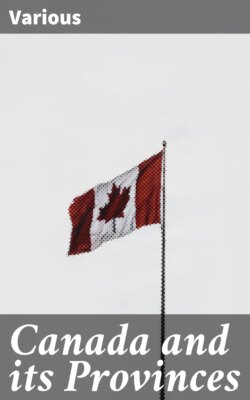Читать книгу Canada and its Provinces - Various - Страница 21
На сайте Литреса книга снята с продажи.
ОглавлениеVI
LA ROCHE D’AILLON AMONG THE NEUTRALS
Table of Contents
1626-27
Table of Contents
That part of the Province of Ontario which lies south of the Maitland and Credit Rivers was occupied during the first half of the seventeenth century by numerous scattered villages of the Neutrals, so called from their taking no part in the continuous warfare between their kindred, the Hurons and Iroquois. Their territory also extended eastward of the Niagara River to the borders of the Seneca country. Its once almost interminable forests, pronounced by Charlevoix the finest in the world, have almost disappeared before the lumberman’s axe. Flourishing cities, comfortable homesteads and rich fields of waving grain or verdant pasture have taken the place of the stately growths of maple, beech, oak, ash, hickory, chestnut, walnut and butternut, interspersed with noble pineries, with which the land was once covered. In most places the change has been effected within the last hundred years. The pioneers of the early part of the nineteenth century found the country in its essential features unchanged from its aspect when Étienne Brûlé first gazed upon it in 1615. The streams with which the territory was plentifully watered teemed with excellent fish. Wild game abounded. Flocks of turkeys were everywhere to be seen in the woods and swamps. At certain seasons wood-pigeons literally darkened the sky in countless millions, while the inland waters were covered with ducks and wild geese. Deer in herds of hundreds were frequently to be seen. Bears, wolves, racoons, squirrels, foxes and lynxes were numerous.
The rich soil of the Neutrals’ country was liberal with its gifts. Nut-trees contributed their products for the sustenance of human life. Vines laden with grapes lined the river banks. Apple, plum and cherry trees showered their fruits in their season. In swamps and burnt woods a variety of luscious berries tempted the palate. With a little cultivation the natives added to their store of provisions tobacco, maize, beans and squashes. They manufactured flint arrow-heads and axes. But beyond all other resources the country of the Neutrals was the land of the beaver. It was the chief hunting ground, and rival nations regarded it long with hungry eyes.
When Father la Roche d’Aillon sought the mission to the Hurons, it was with the purpose of going on to the remotest tribes beyond. Brébeuf and de Nouë accompanied him to Georgian Bay to learn the language and customs of the Hurons. Brûlé’s enthusiasm over the Neutrals’ country proved contagious, and Le Caron urged the already eager d’Aillon to proceed thither. He took with him two Frenchmen, Grenolle and La Vallée. As interpreters and traders they were necessary to facilitate his passage. Leaving the Hurons on October 18, 1626, he took a trail which led through the country of the Petuns. A friendly Petun chief supplied porters for provisions and packs. After sleeping five nights in the woods, d’Aillon arrived on the sixth day at the first village of the Neutrals. Five villages in succession gave him a kindly reception. At the sixth a council was held. At d’Aillon’s instance the natives agreed to make an alliance with the French and to enter into direct trade relations with them. They also assented to his remaining to instruct them in his religion, and adopted him as a member of the tribe. His adopted ‘father’ was Souharissen, head chief of twenty-eight towns besides smaller hamlets. The chief’s reputation and authority were unprecedented. This proud eminence had been won by sheer valour in wars against seventeen hostile nations, from all of which he had brought back scalps or prisoners.
Grenolle and La Vallée returned to the Hurons, leaving d’Aillon alone among the Neutrals. Meanwhile the Hurons had become alarmed. Their profits from the traffic between French and Neutrals would be at an end if the latter traded directly with the French. To prevent such a calamity they circulated among the Neutrals extraordinary calumnies against the missionary. D’Aillon was attacked and, after being robbed of his possessions, barely escaped with his life. In recent years, a silver chalice, whose form and pattern date back to the period of d’Aillon’s visit, was found in a cache near Burlington Bay among numerous Indian relics. It may have been part of the booty carried off by d’Aillon’s assailants.
In his description of the country of the Neutrals d’Aillon waxes eloquent. It was ‘incomparably larger, more beautiful and better than any other of all these regions.’ Why did not the company send Frenchmen there to winter? he asks. They might easily replace the long, difficult, and perilous Nipissing route by a canoe route which would be short and easy. The chief difficulty was the indolence of the Neutrals and their ignorance of canoes. They were hunters and warriors, not navigators. The difference in language was slight; Hurons and Neutrals understood each other’s speech.
Gabriel Sagard sought to bring about peace between the Hurons and Iroquois, as a means of furthering trade and promoting missions. Members of the company, however, frustrated his desire, pointing out that the Iroquois would divert the trade of the Hurons to the Dutch. The logic was invincible. Through the jealousy and fears of rival fur traders, both native and European, the inter-tribal wars went on with slight intermission for a century and a half.
The Récollets descended to Quebec in 1628, hoping to return at an early date. The Jesuits, left in charge of the mission, followed in 1629. Further exploration of the West, delayed by the surrender of New France to the English, was not to be resumed until 1634, and the Récollets were to be excluded from any share in the missions they had established.
